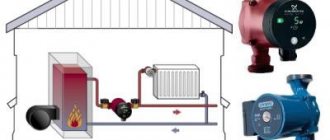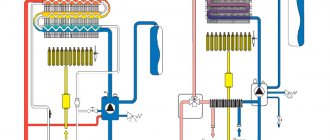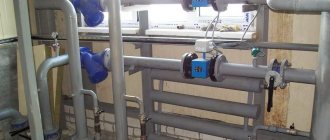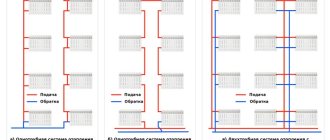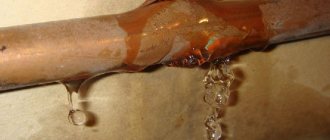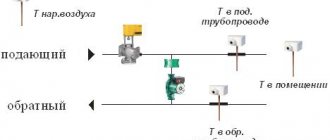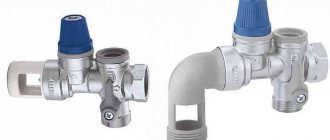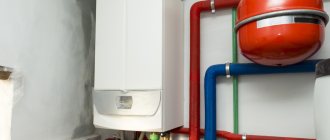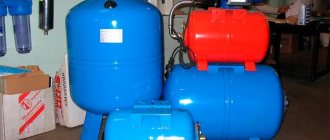Bypass is a side pipe or bypass that serves for the normal operation of the coolant, bypassing heating devices installed in an isolated apartment. One end is connected to the hot water outlet, the other to the coolant input. The bypass allows you to replace radiators in rooms during the heating season, carry out maintenance of heating devices and more. Very often the bypass tap is sacred, which causes controversial debates. Whether this can be done or not, we’ll figure it out in the article.
Three types of bypasses
There are three types of bypasses:
- Unregulated - simple pipe;
- With manual control – valve with divisions;
- Automatic – with sensors;
The latter option is installed in a harness with a pump. Typically, automation is used when circulating a coolant along a circuit. An electrically powered pump allows you to increase the flow rate, which helps reduce heat loss. Most often, such a system is used in private homes or when connecting heated floors to the heating system in apartment buildings. In the event of a power outage, the coolant flow passes through the bypass. The impeller restricts the flow of water. It is supplied to the market in two variations: injection and valve. The biggest disadvantage of an automatic bypass: if the water contains scale, scale, rust and other contaminants, it quickly fails. The bypass must be installed in a single-pipe system; if it is necessary to make a collector wiring, the jumper allows you to divide the flows into two parts, providing both radiators with coolant in equal proportions. With horizontal wiring, the bypass is installed parallel to the main line below the normal wiring. When installing standard three-quarter inch pipes, it is recommended to install a bypass at one-half inch. In this case, the pipes of the incoming and outgoing coolant flow should have a diameter of 1 inch.
What are the requirements for the jumper?
The side jumper to the heating radiator, as already mentioned, is installed in single-pipe heating systems.
According to the requirements for the installation of heating systems, such devices should be installed closer to the battery. The second requirement is that the bypass be made of the same material as the main main pipe. If steel pipes are used in the building, then the lintel is also made of steel pipe. If metal-plastic pipes or polypropylene are connected from the main pipe to the battery, then the jumper is made of this material. The third requirement for installing jumpers in front of the battery is that such a device is installed taking into account the dimensions of the pipes of the main pipeline. The jumper is always installed with a smaller diameter than the inlet and outlet pipes. Most often the difference is taken to be 1 size. For example, if the main pipe is ¾" in diameter, then the bypass should be ½" in diameter.
Connection diagram
The standard bypass connection diagram in an apartment is as follows:
- Pipe with incoming coolant flow;
- Bypass;
- Pipe with outgoing coolant flow;
- Shut-off valves for inlet and outlet.
In this brief description we will look at the operation of a radiator with a bypass. Two valves are mounted at the inlet and outlet of the radiator. The coolant is supplied from below or from above. For most heating systems, the second option is correct. When hot water is supplied from above, the liquid reaches the bypass and is divided into two streams. The coolant is directed to sections of the heating device, heating it. The other flow through the outlet pipe - the bypass, bypassing the radiator, goes down, and then continues its movement along the riser. A valve installed at the radiator inlet allows you to control the flow, increasing or decreasing the coolant supply. A shut-off valve is installed on the bottom of the radiator to allow heat to be removed. During the heating season, the drain valve is opened all the way.
What is bypass
Sometimes it is believed that a bypass is a complex part that can only be installed by an experienced specialist. The reason lies in the complex name of the element. However, many have seen it in the heating system.
In plumbing, a bypass is a kind of jumper pipe. The unit cuts into the bypass of the heating device. With its help, it is possible to alternatively direct the coolant flow. Depending on the design, the jumper is of two types:
- Uncontrolled or open. The jumper is permanently open or has valve devices. In the latter case, if necessary, the water flow is automatically redirected.
- Managed. Taps or valves are installed on the lintel. It becomes possible to manually block or, conversely, open the path for the flow of heating fluid.
Bypass is installed in various parts of the system. Often they are used for piping heating radiators. In country houses where an autonomous system is installed, the jumper is included in the circulation pump assembly. In collector-type communications, the tube is part of the mixing unit. Sometimes the part is used for piping solid fuel boilers.
The jumper performs certain functions
Now the purpose of bypasses is clear. Single-pipe heating is simply unthinkable without this element.
Making a bypass knot is easy. Especially when you need to bypass the heating radiator.
Often the element is combined with radiators
Why install a bypass
More hot water passes through an additional tube connecting the incoming and outgoing flows, and correspondingly less of it enters the radiator. This is normal and fully complies with housing and operational standards, if good circulation of hot water is ensured and the standards for heating the room are observed. In practice, in apartment buildings on the upper and lower floors (depending on the type of coolant supply), there is a significant decrease in temperature in the radiators due to the natural cooling of the coolant. In this case, additional losses through the bypass affect the rate of heating of the room. The hot water supplied to the apartment from the common system, as a rule, circulates poorly due to accumulated rust and scale. In some cases, pipes are installed incorrectly, with a narrowed inlet flow diameter.
The influence of the bypass pipe on energy costs
Installing a bypass will definitely have a positive effect on reducing energy costs. If we compare the operation of a heating system with the use of a closing section and a conventional flow one, then the first will be characterized by a decrease in the volume of coolant supplied to the battery by 30-35%. This means that the heat transfer from the radiator will decrease by up to 10%.
In practice, these changes do not look drastic, if indeed the system is characterized by an excess of heat. In addition, if the size of the heating batteries is chosen correctly, then there is a certain margin of efficiency, and this is the same 10-15%.
So it turns out that such a simple, even primitive at first glance, detail as a bypass is a universal tool for creating a pleasant living environment in the house, despite the fact that energy bills will delight homeowners with small amounts.
What is a bypass in a heating system.
The bypass and the need for its installation when organizing single-pipe or two-pipe heating systems are due to the improvement in the quality of heating of premises in a private house or high-rise apartment. Why do you need a bypass: this is a metal or plastic pipe in the form of a jumper that bypasses one or another heating device. The installation of a bypass itself creates options for redirecting the coolant bypassing the devices being replaced or repaired without turning off the heating in the house. A jumper from a section of pipe to redirect liquid bypass is designed uncontrolled (open), with a valve, or automatic.
The device can serve various mechanisms - heating system pump, pressure gauge, radiator, manifold, underfloor heating pipeline, etc. Bypass is especially important for the uninterrupted operation of the pump - with the correct slope of the pipes, the principle of natural circulation will temporarily replace the pump being repaired, and the heating will not be turned off. It is important to tie radiators with a pipe jumper, especially in a single-pipe circuit, and when including bypass valves in the circuit, a bypass valve is simply necessary. And the last application of the device is to work in the collector unit of two-pipe circuits when mixing supply and return at the inlet or outlet of the boiler.
The jumper can be installed in pipelines made of metal-plastic, polypropylene, steel, cast iron, brass or copper. You can buy the device or make it yourself, but it is not advisable to use metal steel pipes, as they rust and clog the coolant. The best option is heating and bypass made of polypropylene: such a pipeline will work reliably and for a long time.
What problems does a bypass valve solve?
Considering the cost of the work, it makes no sense to dismantle the bypass. Installing an additional valve will help solve the problem of reduced thermal conductivity. After closing the tap on the bypass pipe, all the coolant enters the radiator, resulting in the maximum amount of heat passing through the heating device. If it gets warmer outside or the water temperature in the radiator is too high, the bypass tap can be opened again, and then the apartment will become a little cooler.
How does the bypass work under normal conditions?
So, if we discard the subtleties of calculations and formulas, we can imagine the operation of this unit of the heating system as follows. From the top floor, coolant is supplied through the supply pipe to the bypass installation point. As we know from physics courses, both electric current and liquid always move in the direction of least resistance. If water gets from a 3/4-inch diameter pipe into the section leading to the battery, it will be easier for water to penetrate into the larger diameter pipe. Therefore, only a small part of the coolant enters the bypass with a diameter of ½ inch, the rest of the pressure moves into the battery through a pipe with a diameter of ¾ inch, then it passes through the taps and thermostat and goes into the battery registers. After passing through and partially cooling, the water again exits through the ¾-inch pipe into the main line, and passing through the shut-off valve, it connects with the flow from the bypass and moves further in the general flow.
Valve design
A standard three-quarter-inch valve is designed to provide acceptable pressure and coolant flow rate for one radiator. If you take a standard size pipe and compare it with the diameter of the valve, you can see a significant narrowing in the diameter of the latter. A valve with a smaller diameter is installed to increase pressure. The narrowed hole interferes with the normal circulation of the coolant, thereby disrupting the heat supply to one or more risers. A slight narrowing of the diameter will cause the room temperature of all neighbors to drop. In addition, in the neighboring rooms of the apartment, the batteries will begin to cool faster.
Bypass in a heating system: what is it and what are the benefits of its presence
A high-quality heating system in the house is very important in the domestic climate.
Installing a heating system allows you to maintain the temperature at a given level, even if there is frost or autumn slush outside. Every year, new home heating systems appear on the market, featuring higher efficiency and improved design. But almost every version of this equipment has a bypass. What is it and why is this node needed? The bypass acts as the main element of temperature regulation in batteries. This unit is a jumper , which is made in the form of a pipe. Installation is carried out between the forward and return pipes of the heating main. The bypass regulates the coolant in the radiators. When choosing a bypass, it is very important to understand the features of its operation and how well it will suit your heating system.
Bypass: what is it?
The main purpose of this element of the heating main is to return excess coolant to the battery riser . Simply put, this element ensures the transportation of water to the control valves.
- In the absence of this device, it is much more difficult to repair the battery during periods when the system is in working order.
- Installing this element allows you to ensure the operation of the heating main during periods of lack of electricity (if your heating system is connected to an electric boiler).
If there is a power outage in the house, then it is necessary to turn off the taps through which coolant is supplied to the pump, and then open the tap on the central pipe. If you use a bypass with valves in the heating main , you will not have to turn off the taps manually. This process will occur automatically.
Bypass types:
- with check valve;
- without valve.
Bypasses, which are equipped with a check valve, are used for the circulation pump in the heating main. They are used when the need arises. When the pump is turned on, the valve opens and, under conditions of high pressure, coolant flows through. When the pump is turned off, the valve closes. Note that the valve closes automatically. If it turns out that scale gets onto the bypass, this can lead to it losing its functionality.
Using a bypass without a valve as part of the heating lines , you can perform work in one part of the system without the need to completely shut it down. Installing pumping equipment without a valve allows you to connect to the heating system in a place where there was no radiator.
Automatic bypass
If you decide to install an automatic bypass in your heating system, then you must select this element so that it is one size smaller than the riser pipe . If you do not adhere to this rule, the coolant circulation will stop after installation. This will happen due to the fact that the hydraulic resistance of the battery will be greater than in the bypass.
Please note that the installation of the automatic model must be carried out together with the circulation pump. In this combination, they work autonomously even in cases where there is a power outage. Their work is carried out due to natural circulation.
Bypass installation
It is better not to install a bypass in the heating main yourself. These works must be performed by qualified specialists. They will be able to install this element of the heating system efficiently. After installation, the technicians will check the system for defects, and if there are defects or leaks, they will eliminate them.
The bypass should be installed as close as possible to the radiator and, at the same time, as far as possible from the riser.
If this is necessary, then after installing the bypass, you can install an additional tap. Thanks to it, complete circulation of the coolant will be ensured using the radiator, and not through the bypass.
About responsibility for installing a bypass valve
Having received a dozen complaints, representatives of the housing maintenance service will come with an inspection and quickly discover the problem. The apartment owner will be required to correct problems in the system at his own expense. It is quite possible that the fault for the low temperature in the batteries lies with the housing office itself or the company providing technical repairs. But all accusations will be directed towards the person who installed the tap on the bypass, disturbing the thermal balance. If several people install such taps, this will lead to a heating collapse. The whole house can be damaged. The design of some multi-storey buildings assumes the following: the coolant can rise in one riser, pass along the technical floor, and fall in another, thus continuously circulating. By placing a barrier at one point in the system, the tenant disrupts the thermal balance in two risers at once. Another riser may well be located in the same apartment. The result will be the following situation: one battery, located in the living room, heats better, the other, located in the next room or kitchen, heats worse.
Installation Features
1. valve or thermostatic valve 2. shut-off valve (detentor) 3. air release valve (Mayevsky valve) 4. plug 5. valve 6. bypass
The bypass installation technology is determined by its purpose and location. In heating systems with a single-pipe or two-pipe connection scheme, it should be located as close as possible to the battery. When installing a jumper on a heating radiator, the following rules must be observed:
- Shut-off taps or valves are installed between the battery and the bypass to shut off the coolant flow;
- When connecting the pipe to the radiator, it is equipped with a thermostat, which serves to control the temperature in the room.
In autonomous systems with a gas or solid fuel boiler, the installation of a bypass to ensure natural movement of the working medium when disconnected from electricity is carried out together with the pump. For piping, you should use a jumper, the material of which coincides with the main pipe, and the cross-section is half its diameter. In addition to the circulation pump, the following is installed on the bypass:
- a mesh filter that protects devices from large debris and damage from scale and rust particles;
- check valve When the power is turned off, it prevents the coolant from moving along the small circuit on which the pump is located.
The check valve allows you to switch the circulation of the working medium from forced to natural in automatic mode. For manual adjustment, shut-off valves are placed on the bypass and main pipe.
For large wholesales (from 1000 pcs.) we are ready to offer the best conditions for our radiators →
Installation of equipment on the jumper should occur in the direction of movement of the coolant. Upon completion of installation, to check the tightness of the heating system, pressure testing is performed, which should be 1.5 times greater than the calculated one.
Alternative ways to raise your temperature
The surest solution is to increase the number of radiator sections. The longer the heating device, the more heat it can release into the room. Second method: replace the fans installed at the inlet of the heat flow battery with standard ball valves. Ball valves allow water to pass through the entire ceiling without restriction. Unfortunately, using such a faucet you cannot adjust the coolant flow. A plus is good water circulation in all directions. Another disadvantage of ball valves is the effect of sticking of internal parts. After a long period of inactivity, the faucet stops turning off the flow of water. Ball valves require periodic maintenance. They must be opened and closed periodically.
What is a bypass for and how does it work?
The single-pipe heating distribution scheme is still in demand in individual construction, but in old multi-storey buildings this solution was often used, so installing a bypass pipe was considered a non-discussable and necessary option.
- Ensuring uninterrupted operation of individual components of the heating system without turning off the heat. Repair or replacement of mechanisms, equipment and individual elements in the heating system is facilitated by the fact that the inlet and outlet shut-off valves (supply and return) of the coolant are closed, and the working fluid is redirected through a jumper pipe, as a result of which the broken unit can be easily dismantled or repaired. This is why a bypass is needed in a heating system, but this is not the only purpose of the bypass;
- The functioning of a single-pipe heating system can be improved, since it has a significant drawback: the temperature from the heated coolant is unevenly distributed over the radiators due to their sequential connection scheme. Thus, the temperature in the very last radiator will always be the lowest. To obtain the same temperature on all batteries, install a bypass in front of each heating device - radiator, battery or register. Here, the purpose of the bypass is that a certain volume of media is directed bypassing the radiator sections, and gets hot even into the furthest battery. In this case, the diameter of the pipe jumper in a single-pipe heating system must be equal to or less than the diameter of the pipes of the main circuit;
- Maintain the operation of heating systems during an emergency power outage, since the circulation pump does not function, and the presence of a bypass will make the movement of coolant uninterrupted.
Important: Homeowners often wonder if a bypass is needed in a two-pipe double-pipe heating system? With this pattern of movement of the working fluid, the bypass, after closing the valve, will redirect the coolant to those areas that lose heat the most.
How to solve the problem without a bypass valve
To prevent the bypass from taking away precious heat, you need to install an adapter pipe with a diameter smaller than the inlet and outlet pipes. Liquid always follows the path of least resistance; the lower the pipe diameter, the greater the pressure and vice versa. The water entering the apartment is immediately divided into two streams, the first goes down, the second passes through the battery. Therefore, the rules for using heating appliances recommend setting the diameter of the jumper one unit less than that of the direct-flow pipe. For example, if the pipe diameter is 1 inch, a three-quarter jumper must be installed. This will get rid of the effect of the first sections of the radiator being too hot and the last sections being quite cold. Since the liquid moves into the drainage system with some resistance, the pressure at the entrance to the batteries increases, and all sections receive an equal amount of heat. Narrowed bypasses are provided for by the standards; the local HOA or housing cooperative will have no complaints.
Principle of operation
Photo of the device:
It is not difficult to understand that even initially insignificant defects in the operation of engineering systems and communications can turn into serious problems.
The discomfort and even danger to health caused by heating malfunctions can hardly be overestimated.
That’s why attentive, thoughtful homeowners should be busy preventing such problems. The bypass, which is widely used in heating circuits and plumbing systems, plays a significant role in it.
Its design is not particularly complicated - it is just a jumper in the form of a pipe, supplemented with control devices.
The bypass valve ensures the passage of liquid (drinking water or coolant in the heating system) away from one or another technical unit.
Quite simply, this is a workaround for water in case of unforeseen situations. If everything works normally, the flow moves calmly and measuredly along the jumper.
But under certain conditions, the locking element closes and the liquid rushes away from the previous trajectory. This effect is achieved because the diameter of the bypass is invariably smaller than that of the pipe that supplies water to it.
The use of such a device allows:
- make service work on pipelines much easier;
- increase the efficiency of equipment;
- reduce unproductive energy costs;
- radically solve the problem of filling pipes and other water infrastructure with air;
- guarantee relatively stable performance even in unusual situations.
Sometimes you may come across arguments that installing a bypass is unprofitable. In fact, this is not so - when installing such a device, you can significantly save energy.
The reduction in water supply to the batteries is up to 35%, and therefore it is possible to reduce thermal energy consumption by approximately 15%.
Since many real systems consume a lot of heat, there will be no negative consequences. A more detailed picture can be understood in consultation with specialists.
Is it possible to dismantle the bypass?
It is not recommended to remove the jumper between the two pipes. In the standards for the construction of residential premises, back in the seventies, it was decided to install such jumpers for central heating radiators. The bypass helps ensure the smooth flow of coolant through your apartment, regardless of whether heat enters the radiator or not. Why this is necessary: Without sealing the battery, there is no way to prevent leakage. If the heating device becomes clogged, you will have to turn off the system and leave an entire riser or two without coolant.
In what cases is a jumper not needed?
If there is no tap on the battery that can be used to turn it off, then a bypass on the heating radiator is not needed. After all, there is still no way to shut off the battery without disconnecting the riser.
In cottages and some new buildings there is a two-pipe heating system. In this case, each radiator is independently connected to two pipes - supply and return. A jumper is not used in this scheme, since the batteries do not depend on each other. The temperature in two-pipe systems is usually automatically controlled.

